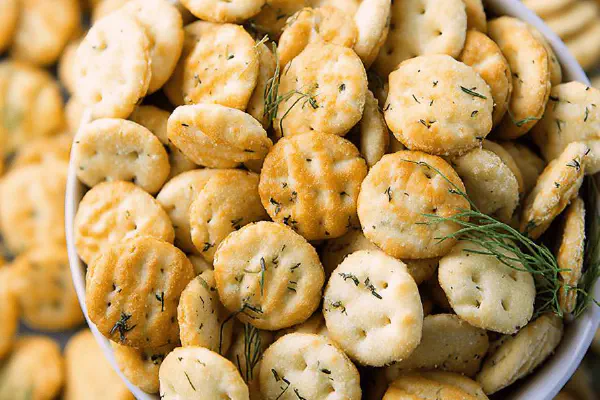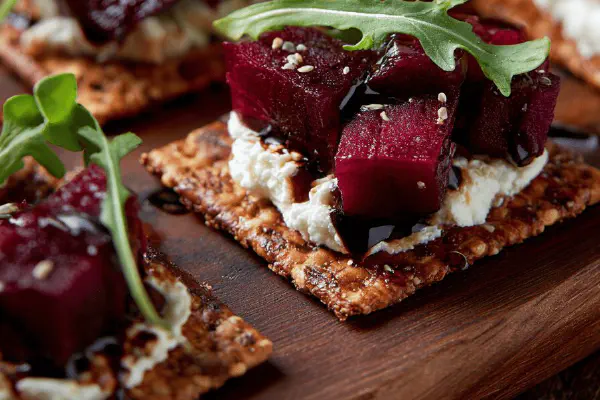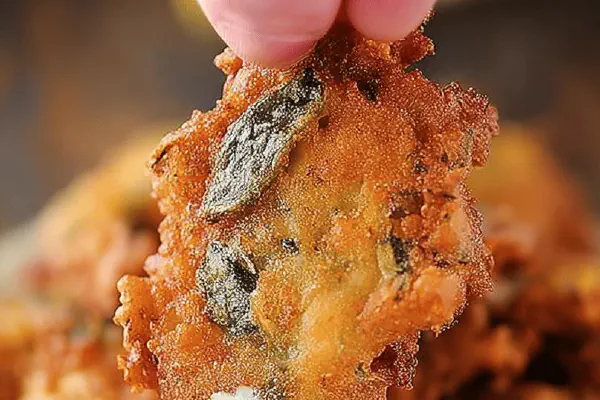Garlic Dill Oyster Crackers

By Emma
Certified Culinary Professional
Ingredients
- 3 cups oyster crackers
- 2 teaspoons dried dill
- 1 teaspoon garlic powder
- 1/2 teaspoon freshly ground black pepper
- 1 teaspoon kosher salt
- 1 tablespoon extra virgin olive oil
About the ingredients
Method
- Preheat oven to 240°F. Line large rimmed baking sheet with parchment to avoid sticking and for faster cleanup.
- Combine dried dill, garlic powder, ground black pepper, kosher salt, and olive oil in medium bowl. Stir until uniform paste forms.
- Add oyster crackers. Toss gently but thoroughly so each cracker gets light but complete coating. Avoid crushing crackers.
- Spread crackers evenly in single layer on baking sheet. Crowding traps steam, makes soggy crackers.
- Place pan in oven. Roast for about 22 minutes watching color change. Crackers will remain pale with slight golden hints on edges. Smell should shift from raw spice to baked herbs and garlic.
- Turn oven off. Leave crackers inside to sit for 25-35 minutes with oven door closed. They crisp up as residual heat dries them further without browning more.
- Remove crackers when warm to touch but not hot. Cool completely before storing. Soggy or warm containers trap moisture, ruin crunch.
- Serve warm if you like, or store in airtight container at room temperature. Keeps well for at least 3 weeks if dry and sealed.
- Adjust seasoning quantities by 10-15% if you want more garlic punch or dill aroma. Substitute dried parsley for dill for a twist. Olive oil can be swapped for avocado or sunflower oil mild alternative.
- Got burnt crackers? Cut bake time or lowest rack next round. Ovens vary. Watch first batch closely.
- Toss brittle crackers to avoid clumps before baking. Crusher bits throw the texture off.
Cooking tips
Chef's notes
- 💡 Low heat critical 240°F or just under. Oven runs hot? Drop 5-10 degrees. Keeps crackers pale golden, not burnt. Watch edges color, subtle shift to brown signals almost done. Smell changes from raw spice to baked herbs; sniff often. Toss gently but well-coat every cracker. Too rough, breaks crackers. Too soft toss, uneven coating. Dry spices work best. Fresh garlic makes soggy clumps; garlic powder spreads uniformly. Olive oil binds flavor, but swap avocado or sunflower in pinch for milder taste or allergy.
- 💡 Don’t crowd crackers on pan. Single layer only. Overlapping traps steam, softens crackers not crisp. Use parchment for cleanup, saves scrubbing burnt bits. After roasting, turn off oven and leave crackers in closed oven 25-35 mins. Residual heat dries further without added browning. This rest step delivers crunch. Removing too early? Crackers chew or limp. Wait till warm but not hot to handle or bag—warm traps moisture. Cool fully before storage to keep texture tight.
- 💡 Adjust seasonings by hand. Want more garlic punch, add 10-15% garlic powder. Diluted dill? Swap parsley dry herb instead. Consider smoked paprika pinch for warmth twist but keep dry. Salt distributes best kosher type, avoids hot spots. Black pepper adds subtle bite; freshly ground preferred. Beware liquid oil overdo makes crackers soggy. Balance oil minimum to coat. Too little oil? Taste flat. Too much? Texture ruins. Oyster crackers preferred for size crunch and batch performance. Saltine substitute only emergency; texture off.
- 💡 Burnt crackers? Cut bake time at least 5 mins or move rack lower next batch. Oven hot spots vary. Watch color/texture over minutes. Toss brittle crackers beforehand. Sticky bits make clumps, uneven coating. Use dry ingredients. Avoid fresh herbs that release moisture or fresh garlic wet spots that burn. Baking long low heat lets flavor build slow, not fast. Rushed bake ruins crispness and aroma. Visual and smell beats timer every time. Crackers just-starting-to-brown edges with herbaceous baked garlic scent is endgame signal.
- 💡 Store airtight and dry. Moisture ruins crunch fast. Room temp okay. Soggy containers trap damp air. Not worth freezing leftovers; texture not same. Retains crunch best freshly baked plus day or two. Parchment-lined pan keeps batch clean, no stuck bits. Adjust herbs seasonings freely; try thyme or parsley if dill not on hand but dill punches flavor higher. Oil swaps mild oils easily. Saltines or other crackers work but change bake behavior. Always chill mentally, slow and steady for better texture and flavor.
Common questions
Why low heat roasting?
Low heat at 240°F avoids burning herbs. High heat darkens crackers too fast, burns edges, not dry enough inside. Smell shifts from raw to baked herbs tell when done. Oven varies, so smell and color help more than clock. Resting in off oven finishes drying and crisps without overcooking.
Can fresh garlic be used?
Fresh garlic clumps, splotches soggy bits on crackers. Garlic powder spreads evenly and dries with oil coating. If fresh garlic needed, mince fine, toss then pat cracker dry fast but risk uneven flavor. Powder gives consistent distribution, prevents hot spots and moisture traps.
How to fix soggy crackers?
Usually too much oil or crowded pan causing steam trap. Spread in single layer, no overlap. Cut oil slightly. After baking, leave crackers in warm oven off 25-35 mins to let residual heat dry better. If soggy stored warm, moisture trapped kills crunch fast.
Best storage for crackers?
Airtight container best, dry environment crucial. Room temp fine up to 3 weeks if sealed and dry. Avoid plastic bags storing warm crackers—moisture plus heat ruins texture. Freezing changes crunch, not recommended. Cool fully before bagging for storage. Parchment liner helps keep crumbs separated.



